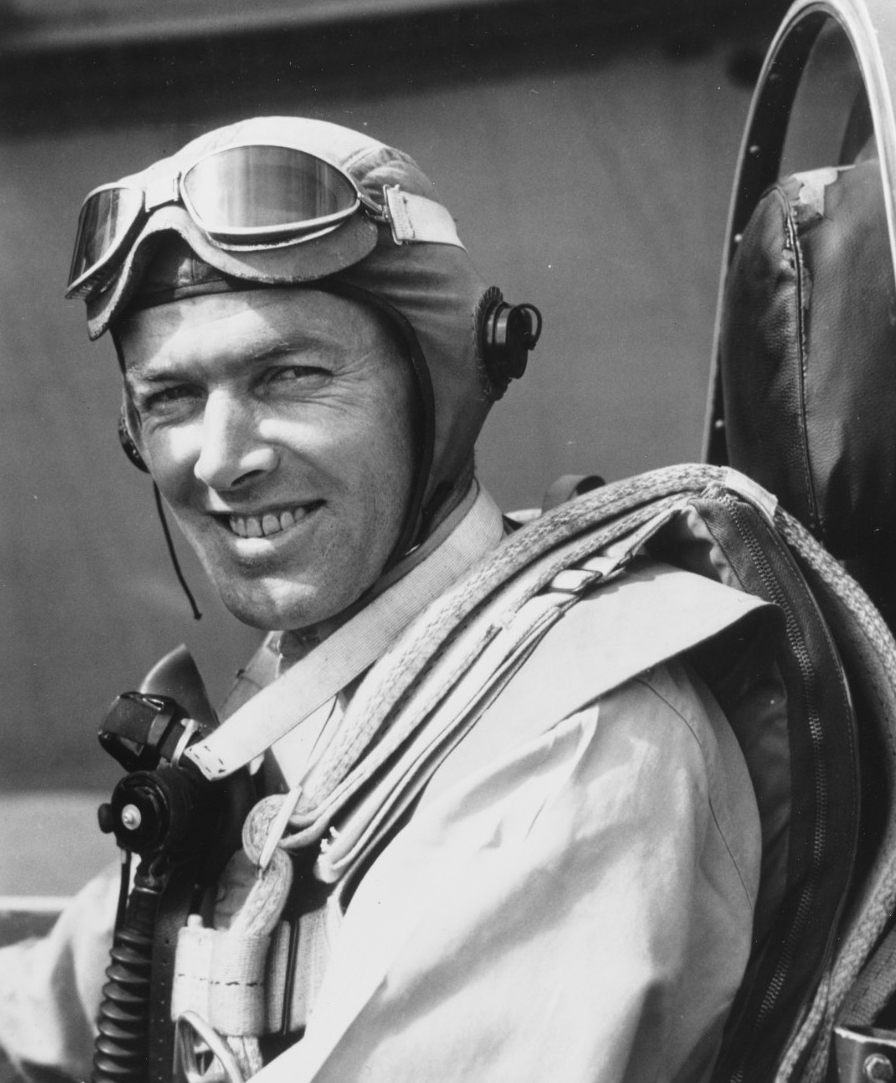
James Henry Flatley Jr. was an aviator and tactician in World War II. A Navy Cross recipient, he was key in passing information and tactics he learned to other aviators about the new fighter, the F4F Wildcat. Born in Green Bay, Wisconsin, he set his sights on joining the Navy. He graduated from the United States Naval Academy in 1929 and was flying in two years. He started his Navy career on the USS Saratoga as a junior officer, the lowest ranking officer. As his career progressed, he was moved to several different naval ships and gained much flight experience, ending his career as a Vice Admiral, just below admiral.
His first major battle was the Battle of the Coral Sea. This was the first major carrier vs. carrier battle which pitted the Japanese against Allied forces in the seas north of Australia. The Allies in the pacific consisted of American Navy and Australian Navy. Flatley and his fellow airmen played a major role in defending allied aircraft carriers and bombers while also destroying Japanese recon planes and fighters. Before the battle, Flatley was called back to form his own fighter squadron, however he asked to remain until the battle was over.
As the battle continued, many in the navy and air force who had fought against the Japanese Mitsubishi A6M “Zero” carrier fighters thought that they were much superior to American F4F Wildcat airplanes due to their maneuverability and climbing prowess. However, Flatley believed that it was the Japanese pilots who were superior and had superior flying tactics. In light of this, he started communicating and sharing different tactics, airplane related tips, flight patterns, and defensive maneuvers with his fellow aviators. One of his greatest tactical and defensive maneuvers he helped to popularize was the ‘Thatch Weave”. While he did not invent the Weave, he did name it after its creator John Thatch. The maneuver allows two planes to defend each other from attacks from behind. This is accomplished by weaving back and fourth on the same elevation. By doing this, enemy fighters can be picked off by the other plane in the thatch. A thatch can also refer to a straw or plant fiber weaved into a basket. This is analagous to the weaving motion that the planes move in during the move. Flatley himself was saved from death multiple times by using the Thatch Weave in combat. The reason maneuvers like this were necessary was due to the low maneuverability and climbing ability compared to the Japanese “Zero” planes. F4F’s were heavily armed with four 50cal machine guns and two wing mounted RPGs. Unfortunately, this extra armament is quite heavy and hindered the turning and climbing rates and made the F4F’s easy pickings for the agile “Zeros”. With these limitations in mind, the maneuver takes advantage of the high fire power of and F4F to quickly dispatch of the tailing plane.
After the battle, he earned the Navy Cross for extraordinary heroism and conspicuous courage. He was then appointed as the leader of VF-10, a squadron of F4F Wildcats. Flatley continued his military career doing several non combat rolls. He helped introduce the new F6F Hellcats to the Navy pilots when his F4Fs began to get out of date. The new airplane had a boost in horsepower from 1200 to 2000 with the addition of a Pratt & Whitney R-2800 radial engine and added two 50 cal machine guns to the F4F’s four. With these upgrades, the “Zeros” were finally outclassed. The increased horsepower made a drastic change in the climbing and turning ability. After the war ended, his first assignment was to address the large safety issues in the Navy like launching safety and fuel safety. This lead to the creation of the Naval Aviation Safety Center, a department of the Navy. This program, similar to OSHA, regulates, documents, and sets standards for all operations. This is the same program that runs today however running under a different name: The Naval Safety Center. Flatley’s first hand experience allowed him to give excellent recommendations and allowed safety regulations to be created to address some glaring safety issues in the US Navy.
Upon his retirement in June of 1958, he was promoted to Vice Admiral. During his career he earned a Navy Cross, a Navy Distinguished Service Medal, three Distinguished Flying Crosses, and a Bronze Star. His unit also received a Presidential Unit Citation. Unfortunately, his retirement was very short. One month after his retirement, he died of unknown causes. James H. Flatley Memorial Park was dedicated in June 1976. It is located on the bank of the Fox River in Green Bay Wisconsin. The park construction and dedication was headed by his former schoolmate Harry Masse in early 1976 and stands there to this day. His son James Flatly III was a test pilot in the Navy and in his career became a Rear Admiral. Even his grandsons became Navy aviators and are currently in the Navy. Flatley was a great man in and out of war due to his heroism and courage in battle. His use and distribution of tactical knowledge during WWII had a real and tangible effect on the Pacific theater and his post-war contributions led to Navy divisions that still exist today.
Primary Sources
April 5, 2005 Issue of the Green Bay Press Gazette
Rauen, Karen . “Green Bay Press-Gazette from Green Bay, Wisconsin on April 5, 2005 · Page 9.” Newspapers.com, Green Bay Press-Gazette, 5 Apr. 2005
Naval History and Heritage Command
“Flatley, James H.” Naval History and Heritage Command, Naval History and Heritage Command, 8 June 2017
“James H. Flatley” .” Revolvy, www.revolvy.com/main/index.php?s=James H. Flatley.
Secondary Sources
Dwyer, Larry . “Grumman F4F Wildcat.” Grumman F4F Wildcat, 6 Nov. 1997, www.aviation-history.com/grumman/f4f.html.
One v One: A6M2 Zero versus F4F-3 Wildcat
Hawks, Chuck. “One v One: A6M2 Zero versus F4F-3 Wildcat.” A6M2 Zero versus F4F-3 Wildcat, Chuck Hawks, 2011, www.chuckhawks.com/1v1_zero_wildcat.htm.
